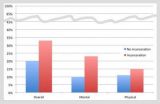(Press-News.org) PROVIDENCE, R.I. [Brown University] — New research shows that people who grew up in a household where a member was incarcerated have a 16-percent greater risk of experiencing poor health quality than adults who did not have a family member sent to prison. The finding, which accounted for other forms of childhood adversity, suggests that the nation's high rate of imprisonment may be independently imparting enduring physical and mental health difficulties in some families.
"These people were children when this happened, and it was a significant disruptive event," said Annie Gjelsvik, assistant professor of epidemiology in the Brown University School of Public Health and lead author of the study published in the Journal of Healthcare for the Poor and Underserved. "That disruptive event has long-term adverse consequences."
The study is based on data gathered from more than 81,000 adults who responded to the Behavioral Risk Factor Surveillance Survey, a standardized national assessment of health. In 2009 and 2010, 12 states and the District of Columbia included questions about childhood adversity, including this question about the first 18 years of life: "Did you live with anyone who served time or was sentenced to serve time in a prison, jail or other correctional facility?"
The states were Arkansas, Louisiana, New Mexico, Tennessee, Washington in 2009 and Hawaii, Maine, Nevada, Ohio, Pennsylvania, Vermont, Washington, Washington D.C., and Wisconsin in 2010.
Gjelsvik and her co-authors analyzed the survey results to see if there were overall health quality differences between those who answered yes or no. In the survey, respondents were asked how many days out of the last month they experienced bad mental or physical health. If the total exceeded 14 days their overall health quality was considered poor.
Of 81,910 respondents 3,717, or 4.5 percent, said they grew up in a household where an adult family member was incarcerated. The proportion rose to 6.5 percent when the total sample was statistically weighted to accurately represent the adult population of each state. The percent of people exposed to an incarceration in the family varied markedly by age (younger people were more likely than older people), by race (blacks and Hispanics were more likely than whites) and by other demographic factors.
Because a number of problems in childhood and later in life can lead to poor health quality, the researchers employed statistical analysis techniques to account for, or factor out, potentially confounding influences including age, education (which was tightly correlated with income), and the total number of other adverse childhood experiences elicited in the survey. Those included emotional, physical, and sexual abuse as well as exposure to domestic violence, substance abuse, a mentally ill household member, and parental separation or divorce.
Even then, they found the 16-percent greater risk of poor adult health quality among those exposed to an incarceration in their family during childhood.
Last May, in a separate paper based on the same data, Gjelsvik's team found that people with family incarcerations in their youth were more likely as adults to engage in smoking and heavy drinking, after controlling for demographics and additional adverse childhood events.
Gjelsvik acknowledged that the studies leave open questions because they did not measure which family member was sent to prison, when, for what reason, or for how long.
But the overall findings argue against sentencing policies such as mandatory minimum sentences for nonviolent offenders, Gjelsvik said. Incarceration can be necessary, but greater appropriate use of alternatives to prison for nonviolent offenders, such as drug courts, could spare some innocent children from a lifetime of reduced health.
"I'm not saying don't incarcerate people," she said. "But we need to allow our system to use judgment and to use innovative and evidence-based programs."
INFORMATION:
In addition to Gjelsvik, other authors are Dora Dumont, Rhode Island Department of Health; Amy Nunn, assistant professor of public health and medicine at Brown University; and Dr. David Rosen, research associate at the University of North Carolina–Chapel Hill.
The National Institutes of Health supported the study (grant: P30AI50410).
Jailed family member increases risks for kids' adult health
2014-08-01
ELSE PRESS RELEASES FROM THIS DATE:
2014 ESC/ESA Guidelines on non-cardiac surgery: Cardiovascular assessment and management
2014-08-01
The publication of the new joint ESC/ESA Guidelines on non-cardiac surgery: cardiovascular assessment and management introduces a number of recommendations in the field. Among other topics, the Guidelines include updated information on the use of clinical indices and biomarkers in risk assessment, and the use of novel anticoagulants, statins, aspirin and beta-blockers in risk mitigation.
Worldwide, non-cardiac surgery is associated with an average overall complication rate of between 7% and 11% and a mortality rate between 0.8% and 1.5%, depending on safety precautions. ...
Chemists develop MRI technique for peeking inside battery-like devices
2014-08-01
A team of chemists from New York University and the University of Cambridge has developed a method for examining the inner workings of battery-like devices called supercapacitors, which can be charged up extremely quickly and can deliver high electrical power. Their technique, based on magnetic resonance imaging (MRI), establishes a means for monitoring and potentially enhancing the performance of such devices.
The work, which appears in the latest issue of the journal Nature Communications, focuses on electric double-layer capacitors (EDLCs), a type of so-called supercapacitor. ...
Management of anticoagulant-associated intracerebral hemorrhage
2014-08-01
Charlottesville, VA (August 1, 2014). The Journal of Neurosurgery is pleased to announce today's publication of a supplement to the August issue entitled "Race Against the Clock: Overcoming Challenges in the Management of Anticoagulant-Associated Intracerebral Hemorrhage." Authored by Peter Le Roux, MD, Charles V. Pollack, Jr., MA, MD, Melissa Milan, MD, and Alisa Schaefer, PhD, the 20-page supplement covers the current knowledge of anticoagulant-associated intracerebral hemorrhage (AAICH) and methods in use for management of the condition. Provided by Paradigm Medical ...
Scientists warn time to stop drilling in the dark
2014-08-01
The co-authors of a new study, including two Simon Fraser University research associates, cite new reasons why scientists, industry representatives and policymakers must collaborate closely on minimizing damage to the natural world from shale gas development. Viorel Popescu and Maureen Ryan, David H. Smith Conservation Research Fellows in SFU's Biological Sciences department, are among eight international co-authors of the newly published research in Frontiers in Ecology and the Environment.
Shale gas development is the extraction of natural gas from shale formations ...
Female baby boomers with asthma? You may need help
2014-08-01
ARLINGTON HEIGHTS, Ill. (August 1, 2014) – Women over the age of 65 face numerous barriers to good health: an increased risk for obesity, greater struggles against poverty and higher rates of asthma with worse health outcomes. An article published in the August issue of Annals of Allergy, Asthma and Immunology, the scientific publication of the American College of Allergy, Asthma and Immunology (ACAAI), outlines the challenges faced by older women in treating asthma, and offers practical solutions to improve their care.
"Allergists want older women to understand that ...
New guidelines help keep asthma out of 'yellow zone'
2014-08-01
ARLINGTON HEIGHTS, Ill. (August 1, 2014) – If you have asthma, you may have an asthma action plan with a "stoplight system" to help you recognize and respond to changes and understand when symptoms are getting worse and need more attention. If you're in the green zone, you're doing well, yellow means your asthma has worsened and action is needed, and red means you require urgent care. New guidelines are now available to help your allergist steer you out of the yellow zone, back into green and away from the red zone.
"Management of acute loss of asthma control in the ...
Recent use of some birth control pills may increase breast cancer risk
2014-08-01
PHILADELPHIA — Women who recently used birth control pills containing high-dose estrogen and a few other formulations had an increased risk for breast cancer, whereas women using some other formulations did not, according to data published in Cancer Research, a journal of the American Association for Cancer Research.
"Our results suggest that use of contemporary oral contraceptives [birth control pills] in the past year is associated with an increased breast cancer risk relative to never or former oral contraceptive use, and that this risk may vary by oral contraceptive ...
Light pulses control graphene's electrical behavior
2014-08-01
CAMBRIDGE, Mass-- Graphene, an ultrathin form of carbon with exceptional electrical, optical, and mechanical properties, has become a focus of research on a variety of potential uses. Now researchers at MIT have found a way to control how the material conducts electricity by using extremely short light pulses, which could enable its use as a broadband light detector.
The new findings are published in the journal Physical Review Letters, in a paper by graduate student Alex Frenzel, Nuh Gedik, and three others.
The researchers found that by controlling the concentration ...
'Fracking' in the dark: Biological fallout of shale-gas production still largely unknown
2014-08-01
In the United States, natural-gas production from shale rock has increased by more than 700 percent since 2007. Yet scientists still do not fully understand the industry's effects on nature and wildlife, according to a report in the journal Frontiers in Ecology and the Environment.
As gas extraction continues to vastly outpace scientific examination, a team of eight conservation biologists from various organizations and institutions, including Princeton University, concluded that determining the environmental impact of gas-drilling sites — such as chemical contamination ...
For bats and dolphins, hearing gene prestin adapted for echolocation
2014-08-01
A little over a decade ago, prestin was found to be a key gene responsible for hearing in mammals. Prestin makes a protein found in the hair cells of the inner ear that contracts and expands rapidly to transmit signals that help the cochlea, like an antique phonograph horn, amplify sound waves to make hearing more sensitivity.
Now, in a new study published in the advanced online edition of Molecular Biology and Evolution, Peng Shi, et al., have shown that prestin has also independently evolved to play a critical role in the ultrasonic hearing range of animal sonar, ...


